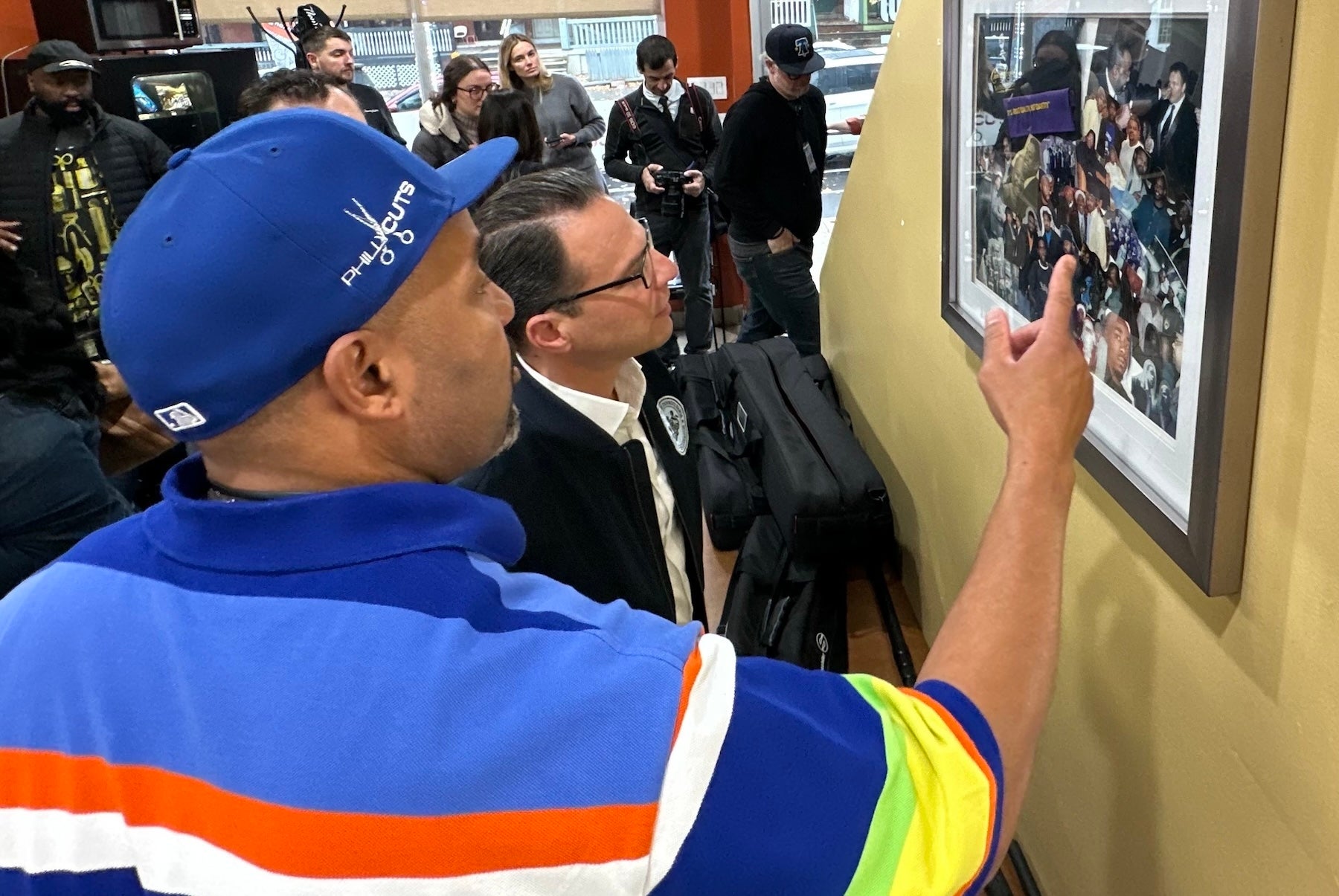Fashion
Paris Fashion Week Jewelry: Notable Designers And Heritage Brands

Celebrating its 35th anniversary in 2025, Amsterdam-based Gem Kingdom Jewelry creates limited … [+]
Every autumn and winter Paris Fashion Week entails a marathon of couture and ready-to-wear runway shows aimed at various genders, income levels and clothing aesthetics. Attracting important clothing designers, retail clothing and accessories buyers and media reporters like birds to their ancestral breeding grounds, Paris Fashion Week also draws thousands of jewelry designers, retail jewelry buyers; jewelry journalists. What’s more, every Paris Fashion Week is a glowing showcase for heritage Parisian jewelry houses like Mellerio, in business since 1613. Herewith a brief overview of notable jewelry trends, heritage jewelry and other intriguing jewelry-related phenomena viewed during SS 2025 Paris Fashion Week.
Berlin-based Gina Melosi’s genderless jewels are made of Fairmined sterling silver and contain … [+]
Genderless Jewelry Is Hot
At the accessories shows Premiere Classe in the Carrousel du Louvre, Tranoī at the Palais Brongniart and Goldrush, in an appointment-only, Le Marais gallery space, genderless jewels proved popular. Alhajah Cult Store (from Spain) which showed at Premiere Classe, billed itself as “Ungendered Jewelry”. Its ultra-textured, chunky statement rings, Chamber of Nautilus charms and necklaces; baroque pearl bracelets, necklaces and earrings all served to verify the brand’s motto and broad appeal.
At Tranoï, 10decoart’s Poland-based Anna Pałubicka (designer) and Konrad Komorowski (brand manager) presented a range of pendant necklaces with charms and other jewels that are as versatile and timeless as they are genderless. Meanwhile at Goldrush, Berlin jeweler/designer Gina Melosi showed supremely sculptural, elegantly textured, somewhat Brutalist sterling silver and Fairmined gold rings, earrings, bracelets and necklaces that complement all kinds of people, ensembles and ages. As Berlin’s first Fairmined licensed brand, Gina Melosi has long embodied avant-garde human jewelry designs and verifiable third-party certified, sustainable bona fides. As she told this writer, “My brand has always prioritized environmental and social responsibility by forging direct relationships with suppliers and partners, reducing our carbon footprint through careful studio management, and by producing gender-neutral designs.”
Classic designs by hum are designed and hand-fabricated in Tokyp with masterful artisanship plus … [+]
Another brand championing genderless jewels is Tokyo-based hum, (yes it’s spelled out in lower case), celebrating its 20th anniversary this year. hum was founded by Tomohiro Sadakiyo and Yuka Inanuma, artisans and designers who share knowledge of and respect for traditional Japanese as well as European jewelry-making techniques, material culture and the allure of mixed precious metal jewelry. At the Goldrush show, Sadakiyo and Inanuma presented 18-karat white and/or yellow gold jewels variously set with pearls, champagne or colorless diamonds. As hum jewels often combine 18-karat white and yellow gold in the same piece, the precious metal contrasts animate the jewels with low-key luxury that whispers confident, serene cool. As Sadakiyo and Inanuma explained at a celebratory dinner at Restaurant TOYO in the sixth arrondissment of Paris, “We design for individuals who, like us, are pursuing original individual paths and are very interested in fine design and advanced artisanship or craft. It is thanks to many retailers and customers that we can continue to create. We are grateful to them all.”
Heritage Paris Jeweler Expands On Tradition With New And Relevant Designs
This design is from the 411-year-old Parisian house of Mellerio, which continues to bring forth … [+]
Curious to see how the longest continuously operating jeweler in Paris is expressing of late, this writer dropped by Maison Mellerio, which is 411 years old and still family-owned. Located at 9 rue de la Paix since 1815, the Maison Mellerio boutique is one of the most artistic, historic and commercial wonders of the jewelry world. In its plush and hushed confines, Mellerio’s fifteenth generation owner, Laure-Isabelle Mellerio, the house’s first-ever female CEO greeted me with warmth. Trained as an interior designer, gemologist and art historian, Mme. Mellerio also serves as the maison’s Artistic Director and President.
The house’s extensive archives include about 100,000 items, including some of its most important jewelry pieces, molds, jewelry renderings, account books, correspondence and the like. Inside the archives, Mellerio executive Dianne-Sophie Lansalle opened ancient order books documenting an impressive number of purchases by Emperor Napoleon III’s consort, Empress Eugenie, who ordered a brooch in the shape of a peacock feather from Mellerio after seeing the original design at the 1867 Universal Exhibition in Paris. (Before Eugenie, Marie Antoniette and Marie de’ Medici were also customers of the maison.) Fun fact: Mellerio premiered bejeweled watches in the 1990s, and continues to produce these as well as stainless steel timepieces,. All of them feature oval-shaped watch faces that are reminiscent of the house’s signature peacock eye motif.
Flash forward to 2024: Lansalle’s presentation of the house’s new Cabinet de Curiosités collection revealed that Mme. Mellerio and her team are creating elegant; easy-to-wear jewelry for 21st century humans that’s inspired by great eras in jewelry history. In fact and festivity, the colored gemstone, pearl, cameo and 18-karat gold Cabinet de Curiosités range references highly colorful and poetic jewels of the Renaissance. In that bygone era, collecting and displaying beautiful, rare and mysterious natural “curiosities” such as gemstones, ancient relics, fossils and other objects flowered in Europe: the goal of many a collector being to amass an array of treasures embodying worlds of wonder.
Reinterpreting Renaissance consciousness in fresh forms and concepts, Mellerio’s Cabinet of Curiosities collection includes one-of-a-kind, luxuriously beaded Lien Pierres bracelets and Lien Pierres necklaces comprised of opal beads, fire opal, pink tourmaline, Tanzanite, moonstone, yellow sapphire, green tourmaline, Mandarin garnet, blue zircon, chrysoprase and emerald beads. (As to its gemstone content, the bracelet contains approximately 38 stone beads that total about 10.45 carats.) The 18-karat gold chain of the Liens Pierres bracelet’s Mellerio-cut shaped clasp opens to accommodate precious charms or poetic, protective talismanic medals, some of which contain colored gemstones and/or diamonds, while others consist of 18-karat gold. All bracelets and necklaces include clasps that are oval-shaped like the Mellerio-cut diamond, which was patented in 2004. This 57-facet, proprietary cut is another reference to the house’s legendary 19th century peacock eye brooch that so captivated Empress Eugenie.
Reminiscent of traditional crests from various world cultures, Talkative Jewellery’s artfully carved … [+]
Kaleidoscopically Colorful Jewels
Known for its luscious use of colored gemstones in brilliant designs, Tokyo-based talkative, designed by Shinobu Marotta, is celebrating its 15th anniversary this year. Along with tiger’s eye, as seen above, talkative’s sliced, gemstone Crest earrings are available in a veritable rainbow of gems and hardstones including lapis lazuli, fluorite, moss agate, mother of pearl, green onyx, amethyst and aquamarine. What’s more, colorful gemstone and diamond rings were also unveiled at the Goldrush show by talkative’s Overseas Sales Director, Yukiko Sugiura. “While talkative operates a boutique in Tokyo,” Sugiura said, “we are looking to expand internationally, which is why we are showing during Paris Fashion Week with a variety of other established and emerging designers in the Goldrush show.”
The Midnight Garden necklace by Cultus Artem glows with chunky black tourmaline crystals, prong-set … [+]
Another brand specializing in super-fine, mega-colorful gemstone jewelry is San Antonio, Texas-based Cultus Artem, designed by Holly Tupper. Fabricated in 18-karat gold designs that evoke the splendors of Asian and Indian jewels as well as European adornments of old, this brand is alive with a large array of notably fine gemstones including diamonds, colored sapphires, pearls and tourmalines. Fabricated by master jewelers with the highest production values and presented in a refined leather jewelry box, Cultus Artem limited edition and one-of-a-kind jewels rightly retail in the haute luxe (high luxury) realm. Uniting rough crystals with beautifully cut and polished gemstones, Cultus Artem jewels embody rare and beautiful contrasts.
Beirut-based Clara Chehab’s style incorporates tumbled color-saturated gemstones with diamonds set … [+]
According to Beirut-based Calra Chehab, “My jewelry highlights the intense colors and textures of tumbled gemstones coupled with textural opposites in the form of crystals or rough-cut gems. To make the designs pop,” she continued, “I sprinkle tiny diamonds in or around the designs.” Indeed Chehab’s smoothly tumbled juicy-pink tourmalines, rough-hewn icy blue aquamarine crystals and smoky brown quartz, all look lovely accented as they are with tiny diamonds and set in either 18-karat yellow gold or rose gold.
Rocking 1970s Revivalism
The sleek silhouettes of Wyld Box Jewelry echo the chic and sexy vibe of the best jewelry from the … [+]
Rosanna Fiedler, founder and designer of Miami-based Wyld Box Jewelry, noted in a face-to-face meeting during Paris Fashion Week that, “My strongest aesthetic influence is the late designer Elsa Peretti.” To Fiedler’s credit, her utterly original fluid forms, sleek finishes and monumental minimalism whisper rather than shout. Presenting in Paris for the first time at the Goldrush show in Le Marais, she said, “I like to think that Wyld Box echoes the understated elegance and cool, carefree spirit of the best 1970s fine jewelry.”
Prova Jewelry founder/owner Irini Arakas designs and hand fabricates exuberantly beaded necklaces … [+]
Fun-Loving Chic
Cheeky-chic and more fun than a ticket to Disneyland, Prova launched in 2024 and specializes in one-of-a-kind, exuberantly colorful; beaded necklaces. Commanding attention and radiating high energy fun, Prova jewels are hand fabricated in New York by founder/designer Irini Arakas, with rare vintage Murano glass and Swarovski beads, various other equally enchanting elements. Centered with tiny figurines of international pop culture superstars like Mickey Mouse, Bambi, Daisy Duck, Smurfs and the Sesame Street gang, Prova (meaning “evidence” or “proof” in Greek) reflects the whimsical taste of Arakas, a former Vogue fashion writer and stylist. Exhibiting during Paris Fashion Week at the Goldrush Show, Prova’s irresistible realm attracted retailers from around the world, including Phoebe Cates, co-owner of New York’s Upper East Side boutique, Blue Tree, which carries Prova in store and on its website.
Berlin-based Lillian von Trapp’s jewels embody 1970s lines and are made of recycled gold and … [+]
Sustainable Substance and Spirit
Characterized by sleek designs that remind this writer of classic 70s jewels, the jewels of Berlin-based Lillian von Trapp, like those of her fellow Berliner and Goldrush exhibitor Gina Melosi are made with environmentally responsible business practices. As she explained in a face-to-face interview during Paris Fashion Week, “We only use repurposed gold or platinum sourced from our clients, or precious metals from vintage jewelry. I believe in designing and producing jewelry this way because it’s easy on the earth.”
The former retail buyer for women’s clothing also has a degree in contract law, and enjoys working closely with clients on designing custom engagement rings and other jewels. As she observed, “I’ve always loved fashion, style and jewelry. I started my brand in 2017, after inheriting some gold, emerald and diamond jewels. I also donate 1 percent of sales to the fashion model Arizona Muse’s non-profit organization DIRT, which is on a mission to grow and process all of the fashion industry’s’s raw materials with biodynamic methods.” (DIRT supports farmers around the world who are growing sustainable cotton, hemp and other fiber materials that are used in the textile industry. von Trapp added, “I’m planning to release a one-of-a-kind pendant soon, from which 100 percent of sales profit will be donated to DIRT.” Given the global environmental situation, one can only hope that more jewelry designers follow von Trapp’s sourcing example, along with her philanthropic commitment to supporting farmers who strive to grow materials for a cleaner, greener fashion industry.










